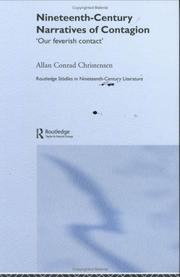| Listing 1 - 4 of 4 |
Sort by
|
Book
ISBN: 9811912955 9811912963 Year: 2022 Publisher: Singapore : Springer,
Abstract | Keywords | Export | Availability | Bookmark
 Loading...
Loading...Choose an application
- Reference Manager
- EndNote
- RefWorks (Direct export to RefWorks)
Communicable diseases in literature. --- Diseases in art. --- Epidemics in literature.

ISBN: 041536048X 0415836158 1134237340 9786611158033 1281158038 0203008235 9780203008232 9781134237340 9781281158031 6611158030 Year: 2005 Publisher: London New York Routledge
Abstract | Keywords | Export | Availability | Bookmark
 Loading...
Loading...Choose an application
- Reference Manager
- EndNote
- RefWorks (Direct export to RefWorks)
This intriguing book examines the ways contagion - or disease - inform and shape a wide variety of nineteenth century texts and contexts.Christiensen dissects the cultural assumptions concerning disease, health, impurity and so on before exploring different perspectives on key themes such as plague, nursing and the hospital environment and focusing on certain key texts including Dicken's Bleak House, Gaskell's Ruth, and Zola's Le Docteur Pascal.
English fiction --- 19th century --- History and criticism --- Medicine in literature --- Literature and medicine --- Great Britain --- History --- Europe --- Epidemics in literature --- Communicable diseases in literature --- Medicine in literature. --- Communicable diseases in literature. --- Epidemics in literature. --- Diseases in literature. --- Medical care in literature --- Medicine and literature --- Medicine --- History and criticism.
Book
ISBN: 9780813941776 9780813941783 0813941784 0813941776 Year: 2018 Publisher: Charlottesville, Va University of Virginia Press
Abstract | Keywords | Export | Availability | Bookmark
 Loading...
Loading...Choose an application
- Reference Manager
- EndNote
- RefWorks (Direct export to RefWorks)
"This books examines eighteenth-century beliefs that reading threatened to transform the world by creating new embodied collectives and fomenting large-scale epidemics"--
English literature --- History of civilization --- anno 1700-1799 --- United Kingdom --- Books and reading --- Diseases in literature. --- Epidemics in literature. --- Communicable diseases in literature. --- Literature and medicine --- Medicine in literature. --- English fiction --- Medical care in literature --- Medicine and literature --- Medicine --- Appraisal of books --- Books --- Choice of books --- Evaluation of literature --- Literature --- Reading, Choice of --- Reading and books --- Reading habits --- Reading public --- Reading --- Reading interests --- Reading promotion --- Social aspects --- History --- History and criticism. --- Appraisal --- Evaluation
Multi
ISBN: 9783030948504 9783030948498 9783030948511 9783030948528 Year: 2022 Publisher: Cham Springer International Publishing, Imprint: Palgrave Macmillan
Abstract | Keywords | Export | Availability | Bookmark
 Loading...
Loading...Choose an application
- Reference Manager
- EndNote
- RefWorks (Direct export to RefWorks)
Writing Plague: Language and Violence from the Black Death to COVID-19 brings a holistic and comparative perspective to “plague writing” from the later Middle Ages to the twenty-first century. It argues that while the human “hardware” has changed enormously between the medieval past and the present the human “software” has remained remarkably similar across time. Through close readings of works by medieval writers like Guillaume de Machaut, Giovanni Boccaccio, and Geoffrey Chaucer in the fourteenth century, select plays by Shakespeare, and modern “plague” fiction and film, Alfred Thomas convincingly demonstrates psychological continuities between the Black Death and COVID-19. Thomas highlights the danger of scapegoating vulnerable minority groups such as Asian Americans and Jews in today’s America. This wide-ranging study will thus be of interest not only to medievalists but also to students of modernity as well as the general reader.
Philosophy --- Jewish religion --- Old English literature --- Literature --- History --- History of Europe --- cultuur --- filosofie --- literatuur --- Jodendom --- literatuurgeschiedenis --- Europese geschiedenis --- middeleeuwen --- anno 500-1499 --- anno 1900-1999 --- Europe --- Peste noire --- Épidémies --- Minorités --- Literature, Medieval --- Literature, Modern --- Diseases and literature. --- Plague in literature. --- Epidemics in literature. --- Diseases in literature. --- Plague --- Epidemics --- Antisemitism. --- Violence. --- Aspect social --- Dans la littérature --- Histoire. --- Violence envers --- Crimes contre --- History and criticism. --- Social aspects. --- Literature, Medieval. --- Judaism and culture. --- Philosophy, Medieval. --- Medieval Literature. --- Literary Criticism. --- Twentieth-Century Literature. --- Jewish Cultural Studies. --- Medieval Philosophy. --- History of Medieval Europe. --- 20th century. --- 476-1492.
| Listing 1 - 4 of 4 |
Sort by
|

 Search
Search Feedback
Feedback About UniCat
About UniCat  Help
Help News
News